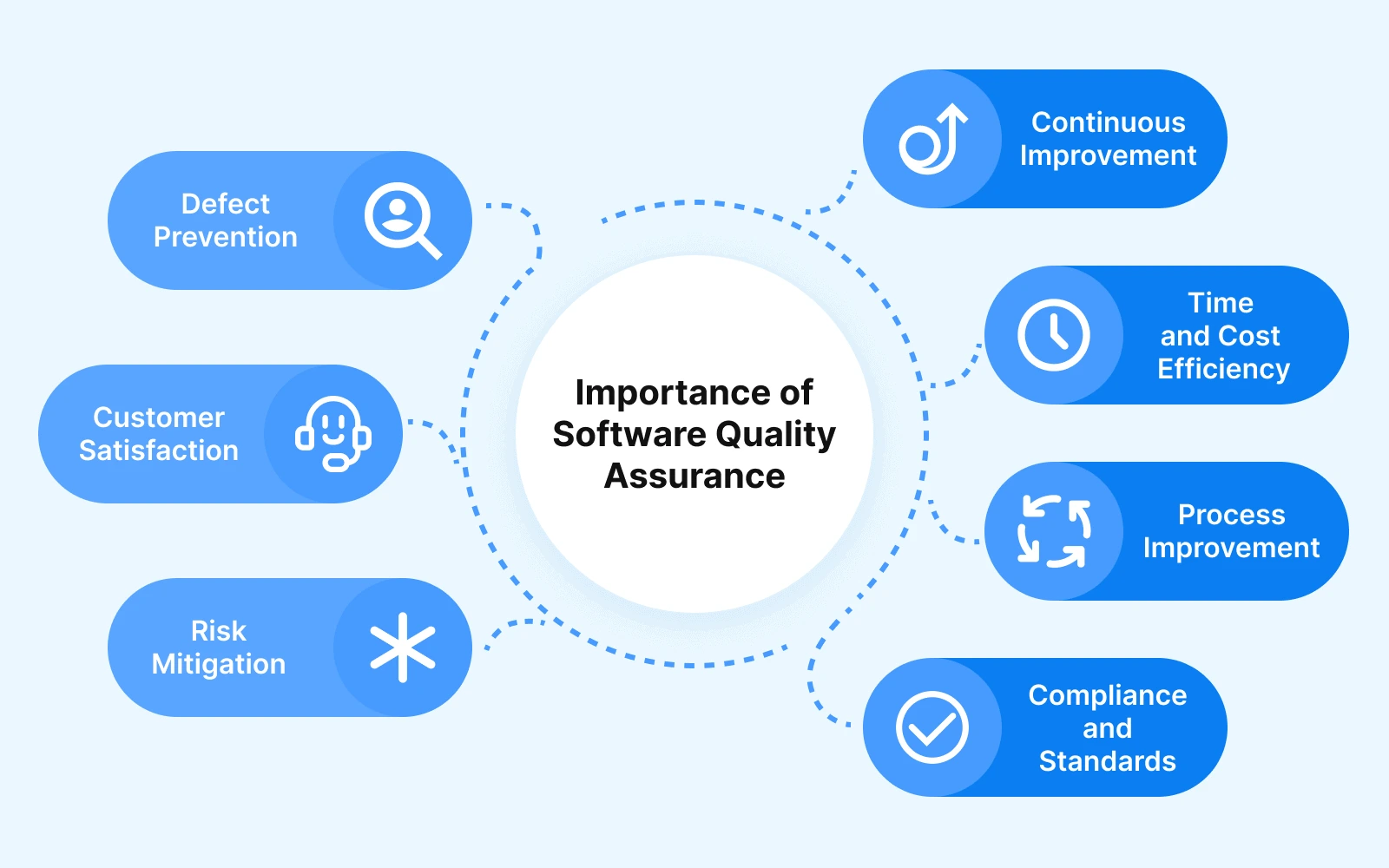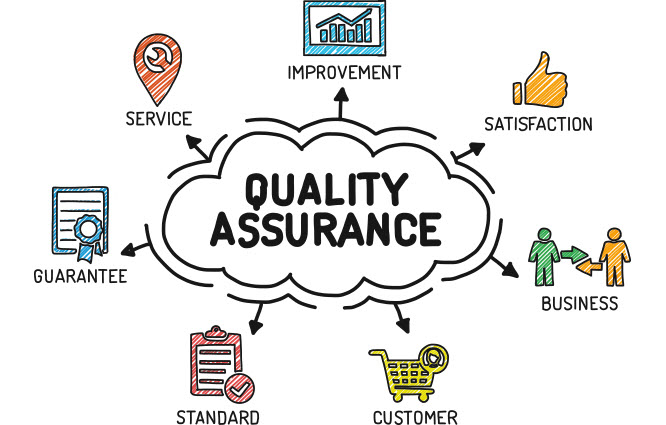Quality Assurance
(2025-09-30T18:14.105Z)
Perplexity Query
(2025-09-30T18:14
.105Z)
Question:
Write a comprehensive one-page article about "Quality Assurance in Software Development".
Model: sonar-pro
Quality Assurance in Software Development (QA) is a systematic process designed to ensure that software products meet defined requirements and quality standards, resulting in reliable, usable, and maintainable applications.
[mueqy0]
In today’s technology-driven world, where software powers everything from mobile apps to critical infrastructure, QA is not just a best practice—it’s essential for building trust, minimizing risks, and delivering value to end users.
[mueqy0]
[agcs19]
By catching defects early and preventing costly post-release fixes, QA directly impacts customer satisfaction, brand reputation, and business success.
[mueqy0]
[zurf3x]

Main Content
Defining Software Quality Assurance
Quality Assurance in software development encompasses a broad range of activities that span the entire Software Development Lifecycle (SDLC), from initial requirements gathering and design through coding, testing, and deployment.
[mueqy0]
The primary goal of QA is defect prevention rather than just defect detection; it’s about building quality into the process from the start, rather than inspecting it in at the end.
[mueqy0]
This is achieved through careful planning, continuous review, and the application of various testing techniques—ensuring that the final product not only works as intended but is also robust, secure, and user-friendly.
[zurf3x]
[agcs19]
Practical Examples and Use Cases
Consider a global e-commerce platform launching a new checkout system. Before going live, the QA team reviews requirements to ensure the checkout process is intuitive, secure, and fast. They design test plans to cover scenarios like payment failures, browser compatibility, and data security. Automated tests are run nightly to catch regressions, while manual testers verify the user experience across different devices. The result: a smooth, bug-free checkout process that boosts customer confidence and reduces support calls.
[zurf3x]
Another example is in healthcare software, where bugs can have real-world consequences. QA teams rigorously test electronic health record (EHR) systems to ensure accuracy, compliance with regulations, and interoperability with other systems. By identifying and resolving issues before deployment, QA minimizes risks to patient safety and helps organizations avoid legal and financial penalties.
[zurf3x]
Benefits and Applications
The benefits of robust QA are wide-ranging. It reduces costs by catching defects early, when they are cheaper and easier to fix.
[agcs19]
It improves time to market by streamlining development and minimizing rework. High-quality software enhances customer satisfaction and loyalty, leading to positive reviews, referrals, and organic growth.
[zurf3x]
For businesses, effective QA is also a competitive differentiator—a reputation for reliability can be a key market advantage.
[zurf3x]
QA is not limited to large enterprises; startups and small teams also benefit from incorporating QA practices, even in agile or DevOps environments. Continuous Integration/Continuous Deployment (CI/CD) pipelines often integrate automated testing tools such as Selenium, JUnit, and Jenkins, enabling rapid feedback and faster releases without sacrificing quality.
[zurf3x]
Challenges and Considerations
Despite its advantages, QA is not without challenges. Ensuring comprehensive test coverage can be difficult, especially for complex systems. Balancing thoroughness with the need for speed is a constant tension, particularly in agile environments. Additionally, keeping up with evolving technologies and user expectations requires ongoing skill development and tool adoption.
[zurf3x]
Human factors also play a role: miscommunication between developers and testers, unclear requirements, and resistance to process changes can undermine QA efforts. Success requires clear communication, well-defined processes, and a culture that values quality as a shared responsibility across the team.
[mueqy0]

Current State and Trends
Adoption and Market Status
QA is now a cornerstone of software development across industries, with adoption rates steadily increasing as organizations recognize its value in risk reduction and cost savings.
[agcs19]
The global QA market is thriving, with companies investing in both in-house QA teams and specialized QA service providers.
Key Players and Technologies
Leading technology companies, from Google to Microsoft, have mature QA processes integrated into their development workflows. The rise of Test Automation, DevOps, and AI-powered testing tools has transformed QA, enabling faster, more reliable releases. Tools like Selenium, Appium, and TestNG are widely used for automated testing, while platforms such as Jenkins and GitLab CI/CD support continuous integration and delivery.
[zurf3x]
Recent Developments
Recent trends include the integration of AI and machine learning in testing—enabling predictive analytics, automated test case generation, and anomaly detection. Shift-left testing (moving testing earlier in the development cycle) is gaining traction, as is the use of cloud-based testing environments for scalability and flexibility.
[foh9hj]
There’s also a growing emphasis on security testing, driven by increasing cybersecurity threats and regulatory requirements.
Future Outlook
Looking ahead, the role of QA in software development will only grow in importance. The proliferation of IoT devices, autonomous systems, and AI-driven applications will demand even more rigorous quality standards. QA will increasingly leverage advanced analytics, real-time monitoring, and self-healing systems to preemptively identify and resolve issues. As software becomes more complex and interconnected, the ability to assure quality at scale—while maintaining speed and agility—will be a critical differentiator for organizations.
[foh9hj]
The future of QA lies in seamless integration with development processes, greater automation, and a relentless focus on user experience.

Conclusion
Quality Assurance in Software Development is essential for delivering reliable, secure, and user-friendly software that meets business and customer needs.
[mueqy0]
[zurf3x]
By embedding QA throughout the SDLC, organizations can reduce costs, accelerate delivery, and build lasting trust with users. As technology evolves, QA will continue to adapt, harnessing new tools and methodologies to meet the challenges of tomorrow’s digital landscape—ensuring that quality remains at the heart of software innovation.
Citations
[mueqy0] 2025, Sep 29. What is Software Quality Assurance and Why is it important?. Published: 2024-05-06 | Updated: 2025-09-29
[zurf3x] 2025, Sep 29. Role of Quality Assurance in Software Development Life Cycle. Published: 2024-02-24 | Updated: 2025-09-29
[agcs19] 2025, Sep 23. Why is quality assurance important in software development? | Blog. Published: 2022-02-10 | Updated: 2025-09-23
[foh9hj] 2025, Jul 29. The Importance of Quality Assurance in Software Testing & How .... Published: 2023-06-01 | Updated: 2025-07-29
[5]: 2025, Mar 03. What Is Software Quality Assurance, and Why Is It Important? - Turing. Published: 2025-02-21 | Updated: 2025-03-03
[6]: 2025, Sep 30. Software Quality Assurance - Software Engineering - GeeksforGeeks. Published: 2025-08-06 | Updated: 2025-09-30
[7]: 2025, Sep 30. The Crucial Role of Quality Assurance (QA) in Software Development. Published: 2023-11-22 | Updated: 2025-09-30
[8]: 2025, Sep 30. What is Software Quality? - IEEE Computer Society. Published: 2024-01-26 | Updated: 2025-09-30
[9]: 2025, Sep 28. What is Quality Assurance (QA)? | Definition from TechTarget. Published: 2024-12-23 | Updated: 2025-09-28